Sir Sydney James Gammell
1867-1946
Sydney James Gammell was the eldest child and only son of The Rev. James Stewart Gammell and his wife Ann Bramley. He was born at the Vicarage of Outwood near Leeds where his father was Vicar, on 25 June 1867.
Presumably, he received his early education locally, either from his father or from a tutor. In 1880, his father left Outwood, and went to live in Clifton on the outskirts of Bristol, and Sydney was sent to Clifton College, which he entered in May 1881, just before his fourteenth birthday. While his father was living in Clifton, Sydney attended as a day boy, but after his father inherited his uncle’s estates in Scotland in 1883, he became a boarder in Brown's House.
Sydney left Clifton in the spring of 1886 after a career at the school, which was not outstanding either scholastically or athletically and went up to Pembroke College, Cambridge, where he graduated as a Bachelor of Arts in 1889. It was while he was at Cambridge that he met his future wife, Alice Stobart, sister of Henry Stobart, a University friend. After leaving Cambridge, Sydney spent a year visiting Australia and New Zealand with another University friend, P. B. (Baccy) van der Byl. Sydney was a keen photographer, even in those early days, and brought back many fascinating photographs, especially of New Zealand, a country which seems to have impressed him much more than did Australia.
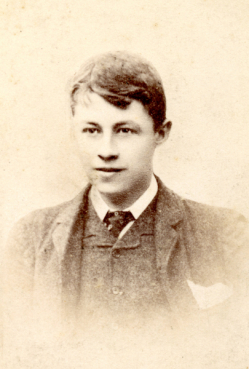
Above: Sydney at Clifton
Below: Sydney with the Stobart sisters, and Sydney and Alice in about 1891, when they married.
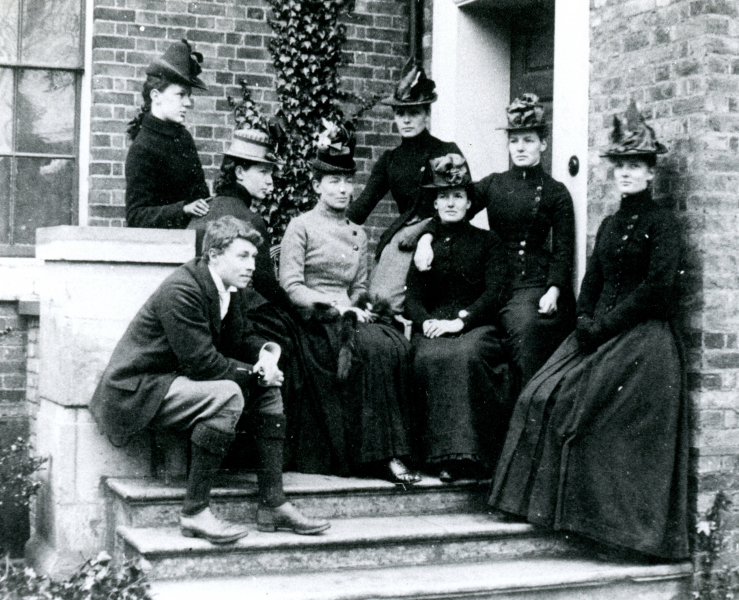
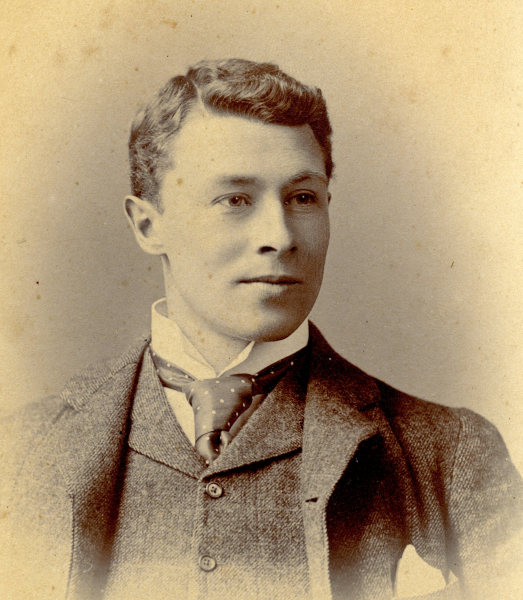
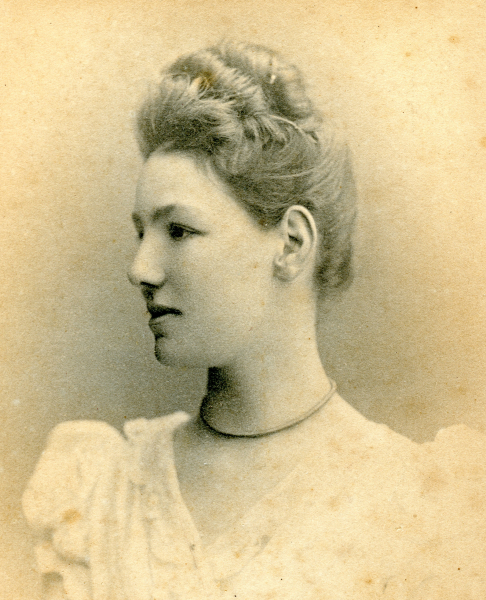 On his return from Australia, he became engaged and married Alice Trench Stobart, the fifth daughter (out of 9!) of the Rev. Henry Stobart, erstwhile vicar of Warkton in Northamptonshire, but then living in retirement at Wykam Rise, Totteridge, Herts, and his wife Annie Mulholland of Northern Irish descent.
On his return from Australia, he became engaged and married Alice Trench Stobart, the fifth daughter (out of 9!) of the Rev. Henry Stobart, erstwhile vicar of Warkton in Northamptonshire, but then living in retirement at Wykam Rise, Totteridge, Herts, and his wife Annie Mulholland of Northern Irish descent.
The wedding took place at Totteridge Church on 28 October 1891, and after a short spell at Drumtochty with his parents, Sydney and his wife settled in Edinburgh first at 7 Circus Place, and then at 5 Gloucester Place, and he went to work with a firm of Factors, with a view to learning Estate Management. While Sydney and his wife were in Edinburgh, their three eldest children were born:
|
|
Born |
Died |
|
26 September 1892 |
1 August 1975 |
|
|
2 October 1894 |
5 November 1977 |
|
|
4 February 1896 |
31 August 1918 |
Towards the end of 1896, the family moved to a rented house in Aberdeenshire, Westhill House, Skene, quite close to the estate of Countesswells, which Sydney started to manage together with Ardiffery in Northern Aberdeenshire. While at Westhill their fourth child was born:
|
|
Born |
Died |
|
20 August 1898 |
9 November 1995 |
The family remained at Westhill until 1899, when Sydney's father James Stewart died, and he inherited the whole of the latter's landed property. These estates amounted to nearly 20,000 acres, but his father, having spent freely out of the many thousands of pounds left him by his uncle Andrew some fifteen years earlier, left little or no cash as working capital after legacies. Sydney also inherited Lethendy and Whitewell from his uncle John in 1902, but again the legacy included no money to support the management of the lands. In spite of having to rely solely on revenue from his estates to support himself and his ever increasing family, Sydney moved to Drumtochty Castle, and there their fifth child was born and named after the hill onto which Drumtochty looked:-
|
|
Born |
Died |
|
16 May 1901 |
5 July 1987 |
Life at Drumtochty was carefree, with large shooting parties in summer and autumn, with amateur dramatics a feature, and a happy lighthearted atmosphere prevailed. Sydney bought his first motor car in 1901, an Argyll, and was active in local affairs, being a Captain in the Fife and Forfar Coast Artillery, a member of the Kincardineshire County Council and was the Conservative Parliamentary candidate for Kincardineshire in the 1906 general election, and again in a by-election in 1908, but in both cases he was defeated by the Liberal Candidate. It was at this time that Sydney became deeply interested in Forestry. He became great friends with other large landowners such as the then Lord Lovat, Mr. Munro Ferguson who later became Lord Novar, Sir A. Stirling Maxwell, Sir John Gladstone and others, all of whom were great foresters, and Sydney began very extensive tree planting programmes, both at Drumtochty and at Countesswells. He was a prominent member of The Royal Scottish Arboricultural Society from 1896 until the 1920s and was a vice-president from 1914 to 1920.
In 1905 in an effort to cut expenditure at a time when agriculture was becoming very depressed, and rents could no longer anything like cover farm maintenance plus living expenses, the family moved to the smaller house of Countesswells; and Drumtochty and Glenfarquhar Lodge were separately let, the latter with the main grouse shooting.
As has already been stated, Sydney, although he had inherited vast stretches of land, had been left little in the way of capital to run them. Added to this all were entailed, except Lethendy, and therefore could not have been sold, even if Sydney had been so inclined. He had therefore little room for manoeuvre to raise money, other than borrowing from the Bank to keep his farms in a good state of repair and to cover his not inconsiderable living expenses; this he did to an extent which even at the time, and certainly in hindsight, was quite unjustifiable.
Although moving back to Drumtochty for a short spell in 1907 while Countesswells was being altered, Countesswells became the family home for the next twenty years, and it was there that the four youngest children were born:
|
|
Born |
Died |
|
9 October 1905 |
19 May 1997 |
|
|
13 February 1908 |
24 May 1999 |
|
|
Ronald Forrester Gammell |
4 April 1910 |
18 June 1910 |
|
24 November 1913 |
6 December 1984 |
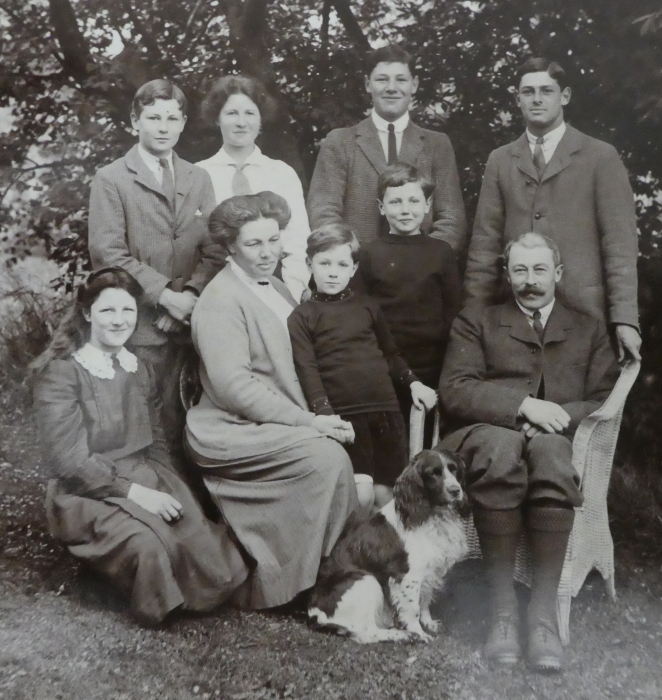
Sydney and Alice, with (left to right) Finella, Dick, Barbara, Edward, William Henry and James in about 1913 (Frank Gourlay)
In 1913, on the coming of age of James Andrew Harcourt, it was possible to break the entail, and this was done, and the estates of Drumtochty with Delavaird and Glenfarquhar put up for sale, with the object of paying off the heavy mortgages which had been raised. Unfortunately, no suitable offer was received, so in fact these estates were not sold until 1915, when, owing to the war, the price obtained was far from satisfactory. To compensate James Andrew Harcourt for the breaking of the entail, the estates of Lethendy and Whitewell were handed over to him by his father in 1921, when by mutual agreement, these were also put on the market.
During the 1914/18 War, Sydney worked in the War Office, and in the Board of Trade and Ministry of Supply on the Home Grown Timber Commission, and was closely involved, particularly in Scotland with the tree-felling programme, which was being carried out with the aid of German Prisoners of war.
He carried the rank of Captain in the Royal Garrison Artillery, and it was while he was engaged in this war-time forestry work that he realised the importance of timber to this country's war time economy. He saw clearly that only by close co-operation between landlords and Government could a satisfactory reafforestation plan be brought to fruition, and a satisfactory safeguard for the future be achieved. In 1917 he therefore wrote a paper for publication in 'Scottish Forestry' entitled 'Co-operation between the State and Private Owners for afforestation of barren Lands', and there is little doubt that these views, plus the activities of his forester friends mentioned earlier, were largely instrumental in bringing about the formation of the Forestry Commission, one of the few organisations in which Government and private interests have successfully co-operated.
On his demobilisation in 1919, Sydney returned to his family at Countesswells and to the management of his remaining estates, he was a good and knowledgeable landlord, and popular with his tenants, but finance was a continual problem, and maintenance and improvement of farm buildings a constant worry. He took in hand the tenancy of one farm, Longside, on the Countesswells Estate, and for several years farmed it with modern methods, including the use of an early Fordson Tractor, which entirely eliminated the need for horses, an innovation almost unheard of in those days. He also built a silo for the storage of fodder, another experiment far in advance of its time.
Sydney was an enthusiast for motoring. In 1904 Sydney bought an Argyll (right), but he sold this car in 1907 and bought in its place one of the very first cars made by Rolls-Royce. This was a 10 HP 2 cylinder model, of which only a very few were made, and was one of the 26 experimental cars made by the firm before they went into full production of the Silver Ghost. The registration number of both cars was SU-13.
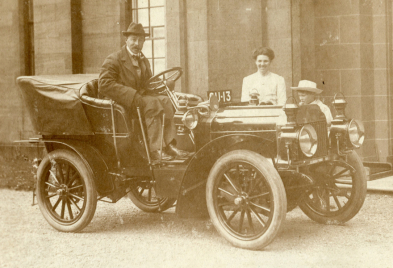
The Rolls-Royce served him well for a full thirteen years, and ran well over 100,000 miles, including many pre-war tours of England - quite a hazardous undertaking in those days of unsurfaced roads, and little or no garage facilities. In 1920 Sydney presented this old car to Rolls Royce driving it down to Derby with his daughter Finella. It was preserved at the Rolls Royce works for many years and put on show quite frequently. In the late 1960s Rolls Royce placed it on indefinite loan with the Lord Montague Motor Museum at Beaulieu in Hampshire. It now belongs to Bentley motors. A modern photograph of that car, together with many of his children, was taken in 1976. See here.
In the 1920s as agriculture continued depressed and unremunerative, Sydney's finances suffered further. He was not basically a man of business or financially shrewd, so the estates prospered less than might otherwise have been the case, and his factors Davidson and Garden of Aberdeen were not of great help either. The farms on the estate of Ardiffery were gradually sold off, and the estate of Countesswells itself put up for sale in 1926. No satisfactory offer however was received, so Sydney built - and largely designed - a charming house of five bedrooms, which he called Netherton Lodge, on a site not far from the South Drive gates of Countesswells. This house was modern compared with Countesswells, which had only switched from paraffin lamps to electricity (a private plant) in about 1924, and had no central heating of any sort. Countesswells House was let and the estate transferred to a trust, run by Sydney's two eldest sons, and his eldest daughter's husband. After a couple of years at Netherton Lodge, however, this house was again found too expensive, and Sydney and his wife moved into the town of Aberdeen, and eventually settled at 68 Gladstone Place, a small terraced town house, unpretentious, but at least convenient to amenities, and perhaps more suitable to the 'over 60s'.
Ever since his return from the 1914/18 War, Sydney had continued his great interest in politics. He was a clever and witty political speaker, and campaigned assiduously in the Conservative cause, and indeed was largely responsible for getting a Conservative returned for Aberdeenshire in the mid 1920s. He was on the Board of Governors of the Aberdeen Sick Children's Hospital, and busied himself in many other welfare activities. In 1928 he was created a Knight Bachelor for 'political and public services in the North East of Scotland'. This was a fitting reward for the many years of service he had given to various public and political ploys.
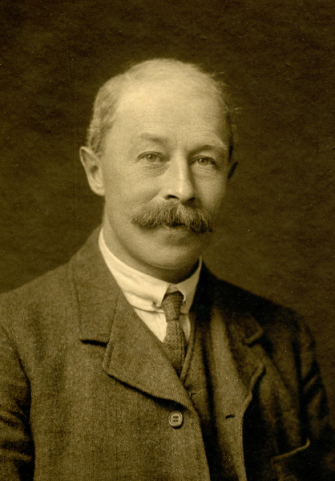
Above: Sydney in 1926
Below: Sydney in later life, date unknown
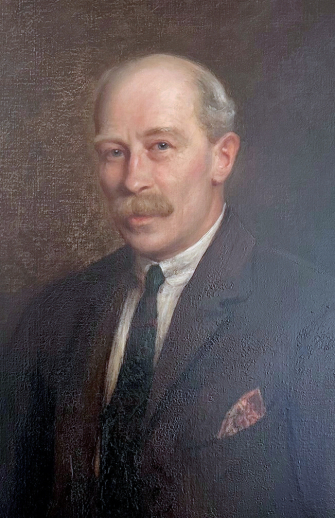
In spite of retiring to Aberdeen and giving up entirely his control of the family estates, he continued his interest in inventive ideas, and in the late 20s or early 30s patented a form of poured concrete construction for houses, the double walls being made by ingenious shuttering, and having removable cores to form the hollow between the two walls of poured concrete. The process was named 'Tesswell T T Construction', and there is a cottage just outside Cults on the Countesswells estate, which he built using the Tesswell process. In spite of forming a small company, however, he was unable to make Tesswell a success, or to interest construction companies in it, and the firm folded up.
Sydney and his wife lived reasonably happily in Aberdeen, but by the time the Second World War broke out in 1939, age was beginning to tell. Sydney himself was troubled with arthritis in his hip, which affected his mobility, although he still drove his car with enthusiasm, while his wife had a bad fall, entailing a broken humerus, which severely affected her nervous system, and from which she never really recovered for the rest of her life.
Sydney died suddenly on 25 February 1946 of a heart attack brought on by cranking his car, because of a flat battery.
He and his wife had been happily married for over 54 years, and had together faced many up and downs in life, from the affluence of Drumtochty in the early days, to a small terraced house in Aberdeen, but this did not appear to affect them unduly, and they accepted their change in circumstances philosophically, and looked back over and talked of, always with pleasure, the earlier years at Drumtochty and Countesswells. After Sydney's death, his wife went to live with her eldest daughter and her husband in Forfar. There she remained for over ten years, most of the time a semi-invalid, until she eventually died on 20 June 1957.
Sydney and his wife were both cremated, and their ashes are interred behind the altar in the Church of St. Paddadius in the glen of Drumtochty. There is a brass plaque on the North Wall of the aisle, put there by their children, commemorating them, and The Rev. James Stewart Gammell, Sydney's father who built and endowed that church.
